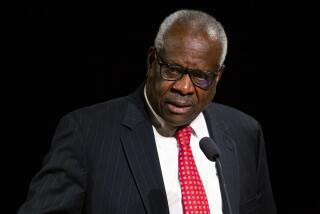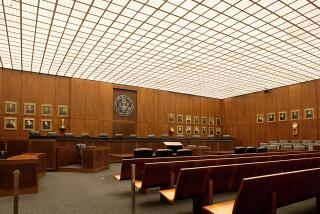U.S. Recoups Only Fraction of Funds From S&L; Frauds
- Share via
WASHINGTON — The federal government has collected just $365,000 out of $83.6 million in court-ordered fines and restitution from individuals convicted in the nation’s top savings and loan fraud cases, the General Accounting Office reported Thursday.
The finding raises questions about the government’s effectiveness in recouping funds stolen or misappropriated by corrupt thrift operators. Hundreds of S&L; failures nationwide, many linked to fraud, are expected to cost taxpayers more than $500 billion over 40 years.
The Justice Department has made prosecution of thrift and bank fraud one of its highest priorities. Although the government has successfully prosecuted thrift fraud cases, the GAO found that it has been highly ineffective in collecting stolen money.
The GAO report involved the top 100 criminal referrals of thrift fraud made to the Justice Department. The cases involved individuals at 55 failed thrifts nationwide. Some highly publicized cases, such as Lincoln Savings & Loan, are still pending and are not included.
In the surveyed cases, the government obtained indictments against 219 individuals whose allegedly fraudulent activity caused losses of $597 million, the GAO said. The government won convictions of 145 defendants in those cases.
The court ordered those convicted to make restitution of $79.1 million to the government and to pay fines of $4.5 million, the GAO said. But only $349,810 in restitution and $15,200 in fines has been collected, the agency said.
In the failure of Brookside Savings & Loan in Los Angeles, for instance, the court ordered restitution of $1.25 million and nothing has been collected. At Odessa Savings in Texas, restitution of $7.2 million was ordered and nothing was recovered.
In the 100 cases reviewed, the government collected less than half of 1% of the total fines and penalties, the GAO reported.
In a hearing before a Senate subcommittee Thursday, Ira Raphaelson, the Justice Department special counsel in charge of S&L; cases, said that recouping funds from those who committed fraud is difficult. Often, he said, “the money is not there.”
When skeptical senators pressed him, Raphaelson said the department does not have full responsibility to recover the money. He also said that courts will not tell the Justice Department when fines are imposed and that he would need a costly new computer system to track the money.
Democratic senators voiced incredulity at Raphaelson’s response.
“This is the kind of thing that drives the public crazy,” Sen. Richard H. Bryan (D-Nev.) said. “We ought to do a lot better job in recovering from thieves who stole from the S&L; industry.”
Committee Chairman Alan J. Dixon (D-Ill.) quoted the 1990 Crime Control Act, which says the Justice Department in fighting financial fraud should be responsible for “restitutions collected and levied.”
“I am concerned that Congress and the public do not have sufficient information to know if we are effectively investigating and prosecuting bank and thrift fraud,” Dixon said. He noted that Congress gave the Justice Department $75 million in 1989 and another $162 million in 1990 to hire additional FBI agents and prosecutors to work on S&L; fraud cases.
But Raphaelson defended the government’s efforts to collect restitution from felons.
“I have seen no case where there is a lump of money the U.S. attorney is ignoring,” he said. “There is no reason to fear bankers who have gone to jail will come out” and enjoy a Cadillac and a Renoir painting, Raphaelson said.
Bryan reminded Raphaelson that the 1990 legislation directed the Justice Department “to serve as the lead dog and collect every dollar” lost in fraud.
Raphaelson responded that “we do not have the financial capability to set up a national system to tell us where every dollar is.” He said some money owed in fines may be collected by the institutions victimized by frauds, and some may be collected by the courts without notifying the Justice Department.
Raphaelson insisted that fraud against banks and S&Ls; remains “the No. 1 white-collar crime priority of the Department of Justice.” Overall, he said the department had charged 2,654 defendants in financial fraud cases, resulting in 2,041 convictions and 82 acquittals. “I’ve spoken with bank groups--they’re scared,” he said. “There’s a deterrence out there.”
The subcommittee members were impatient and angry with Raphaelson because the S&L; issue, already the costliest financial rescue in U.S. history, becomes even more sensitive politically when fraud is involved.
Most of the losses at individual S&Ls; come from the collapse in the real estate markets, especially commercial real estate, which wiped out the value of many construction and development loans. However, the losses linked to falling markets are complicated by and sometimes exacerbated by fraud. Some of the loans were based on falsely inflated property values. Sometimes, S&L; insiders swapped properties back and forth at ever-higher prices before unloading them on the financial institutions for huge loans.
Some degree of fraudulent activity contributed to nearly 60% of the S&L; failures investigated by the Resolution Trust Corp., the agency handling the S&L; cleanup, Dixon noted.
More to Read
Inside the business of entertainment
The Wide Shot brings you news, analysis and insights on everything from streaming wars to production — and what it all means for the future.
You may occasionally receive promotional content from the Los Angeles Times.










